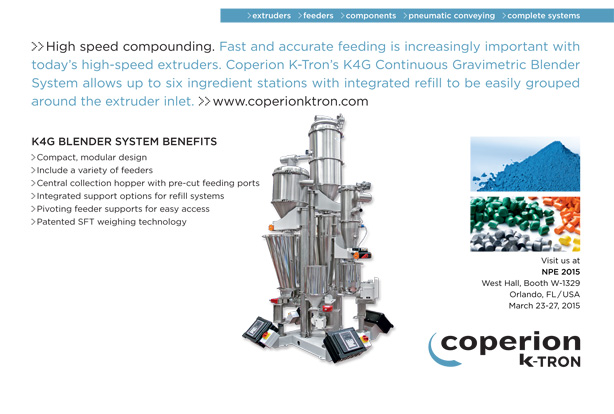Plastics Joining in Medical Devices: Choosing the Right Technology
From micro to macro, medical applications are demanding much more from plastics joining methods
Previous Article Next Article
By Tom Hoover, Market Segment Manager, Medical & Business Consumer Electronics
Branson Ultrasonics Corporation, Danbury, Connecticut, USA
Plastics Joining in Medical Devices: Choosing the Right Technology
From micro to macro, medical applications are demanding much more from plastics joining methods
Previous Article Next Article
By Tom Hoover, Market Segment Manager, Medical & Business Consumer Electronics
Branson Ultrasonics Corporation, Danbury, Connecticut, USA
Plastics Joining in Medical Devices: Choosing the Right Technology
From micro to macro, medical applications are demanding much more from plastics joining methods
Previous Article Next Article
By Tom Hoover, Market Segment Manager, Medical & Business Consumer Electronics
Branson Ultrasonics Corporation, Danbury, Connecticut, USA

In application development, starting with a process-neutral approach is important in selecting the right plastic joining technology.

In application development, starting with a process-neutral approach is important in selecting the right plastic joining technology.

Plastics joining is literally a life-and-death issue for today’s medical industry.

Cannula, luers, and fittings: all examples of plastics welding used by the medical industry.
A surgeon uses an endoscopic instrument to look inside a knee during reconstructive orthopedic surgery. A patient effortlessly manages his diabetes, or a physician quickly diagnoses disease, using a microfluidic device. Both applications use different types of technologies to join the plastics used to manufacture these important medical devices.
As the medical device industry continues its rapid growth of complex, revolutionary devices, so will the need for joining plastic devices ranging from micro-scale tubes to macro monitors and pumps. Choosing the best method of assembly for your plastics applications is crucial, where reliability, performance, quality, and regulatory compliance are essential.
When selecting a technique or supplier for your assembly needs, it’s imperative to examine and compare all the options, to determine which may be best for a given application. It’s necessary to understand the advantages and limitations of each process available—and to work closely with equipment or system providers with the expansive technical expertise to develop a solution that works for your application.
While it can be daunting, your best bet in selecting a process for your application is to go into the decision-making process with an open mind and be “process neutral.” Working with a supplier who does not favor one technology over the other at the outset also can provide the advantages of reduced time-to-market, lower costs, and improved product reliability.
A Wide Range of Technologies to Consider
Many joining technologies exist for medical device applications. While ultrasonics is the dominant technology used for medical devices, other options, such as laser systems, open the door to new opportunities. And for many applications, utilizing a combination of techniques provides the best solution.
Plastics joining technologies include ultrasonic welding, vibration welding, hot plate welding, spin welding, and thermal processing. In addition, clean joining techniques (CJT), which include laser welding, infrared (IR) welding, and vibration-plus-IR welding, are specially designed to minimize flash and particulates.
Joining processes also can support ecological standards and requirements for recyclability, eliminate the need for chemical solvents and adhesives, and are highly energy-efficient.
Ultrasonics
Ultrasonic assembly is an extremely cost-effective and popular technique whose benefits include speed (most welds take less than a second), no consumables, minimal or no setup time, low cost of capital equipment, and easy integration into automation.
It utilizes a series of components—power supply, converter, booster, horn (or stack), and actuator—to deliver mechanical vibration and force to the parts. This generates heat at the interface of the mating surfaces, melting the plastic and creating a strong bond.
In medical devices, high precision and perfectly clean joints are typical requirements. Other joining methods can have drawbacks. Adhesives have much longer set-up and processing times and can cause contamination, especially at the micro level where many of these devices are operating.
Ultrasonics can offer significant advantages for assembly of surgical instruments that are typically joined by screws and solvents. Ultrasonics uses the device material itself to form a bond and does not introduce glues or adhesives into the device, eliminating consumables. It also offers a time savings in production, compared to gluing.
Minimally invasive surgical instruments, as well as catheters, cannulas, luers, and trocars, typically utilize ultrasonic joining.
Clean laser technology
Laser welding of plastics is an innovative welding technique based on the principle whereby laser energy is passed through one plastic component (the transmissive part) and absorbed by the second component (the absorptive part). This absorption results in heating and melting of the interface, and the parts are joined with the application of a controlled clamp force.
Laser welding is a gentle and clean joining process that enables welding of complex geometries and materials that are difficult to bond with other techniques. Laser welding can ensure attractive, reliable hermetic sealing in a single step that only takes a few seconds.
Laser is the technology of choice for joining plastics for in-vitro diagnostics (IVD) devices—as well for as microfluidic devices, such as those used in diabetic care management, where fluidic pathways are very small and so having zero particulate or flash while protecting delicate structures is a primary consideration.
Vibration welding
Vibration welding is a proven friction welding technique capable of producing strong, pressure-tight joints in the thermoplastic parts.
The major advantage of vibration welding lies in its application to large (up to 60”/1524-mm long or 24”/610-mm wide) irregularly shaped parts. Even cross-ribs which create separate compartments can be sealed. The process also works with multi-plane and curved surfaces.
Vibration welding offers the capability of welding more than one part at a time and also readily lends itself to automation. Two motion path options are employed in vibration welding:
- Linear vibration welding uses transverse, reciprocating motion: the vibration occurs in only one axis. The vibration motion can occur equally in both the x and y axes and all axes in between.
- Orbital vibration welding uses constant velocity motion: a non-rotating, offset, circular motion in all directions.
“Clean vibration”
Clean vibration combines infrared and vibration processes, offering more options and applications for smart molding joint design. Pre-heating the surface with infrared can minimize particles generated during the vibration weld phases and produce clean, high-strength joints, with reduced residual stresses and material-specific friction and welding time.
This technology is typically used in manufacturing large, two-part systems such as patient monitors, infusion pumps, or fluid collection vessels.
Spin welding
Spin welding is a friction process that joins circular thermoplastic parts by bringing the part interfaces together, under pressure, with a circular, spinning motion. One part is held stationary in a fixture, while the other is rotated against it under pressure. The frictional heat that is generated causes the part interfaces to melt and fuse together, creating a strong, hermetic seal.The lower-mass half is usually located in the upper spinning portion, but exceptions can be made based on part geometry.
Surgical trocars—which function as portals for the placement of instruments such as graspers, scissors, or staplers—lend themselves to spin welding because of their port’s round geometry.
How to Choose the Right Process
Although the many options available can make it difficult to determine which process is best for your application, here is a thought process that should work for a majority of applications:
- The first consideration is material. Some materials are more readily compatible with a given process. Polyolefins, for instance, are somewhat limited in ultrasonic welding, but are recommended for all of the other processes. Ultrasonics is not recommended for TPRs/TPEs and has limited capabilities in some applications, yet is recommended for others.
- The second consideration is part geometry. Let’s start with the size of the part. One of the limitations of ultrasonics is the size of the tooling. The lower the frequency (15 kHz) used, the larger the tool (approximate maximum: 10” x 10” or 25 x 25 cm). The higher the frequency (40 kHz), the smaller the tool (approximately 2.5” x 2.5” or 6 x 6 cm). If the parts are larger than these ranges, you’ll have to consider using either multiple hits with ultrasonics or another assembly process.
- Delving further into part geometry, we come to the complexity of the part and weld profile. Some assembly processes can accommodate certain features easily and others cannot.
- Wall thickness and internal walls must also be considered. Vibration welding, due to its linear reciprocating motion, has difficulty welding long unsupported walls, while other technologies do not have an issue with these part features.
- Production volumes cannot be overlooked. Some processes, like ultrasonic, spin, and laser welding, will process assemblies in seconds (or faster), while hot-plate welding may take 40-50 seconds. In some instances, you can weld multiple parts in a single cycle to improve throughput.
- Capital equipment cost should be the last consideration, though that may be easier to recommend than to put in practice. Keep in mind that if you select a process based on initial price, you may not have considered long-term product/application development: time to market and processing costs such as scrap, downtime, and mold changes.
Choosing a material joining equipment supplier with a broad portfolio of technologies, application engineers, and experience can be a valuable asset within your overall product development strategy. The “total cost of ownership” for the assembly process, including direct and indirect costs, should be considered.
For new or modified medical devices, all parameters—including design, materials, prototypes, and product performance, as well as processing time and costs—should be thoroughly evaluated to ensure choosing the appropriate joining technique. Again, start with all your options by taking a “process neutral” approach.
About the author…

Tom Hoover has been the market segment manager for Medical & Business Consumer Electronics for Branson Ultrasonics Corp. in Danbury, Connecticut (a business of Emerson) since 2010. Tom brings a vast resource of understanding of the challenges confronting today’s medical device manufacturers and biotech firms. His in-depth medical industry experience in all aspects of product development and regulatory compliance provides him the ability to assist in finding the innovative solutions manufacturers are seeking.
